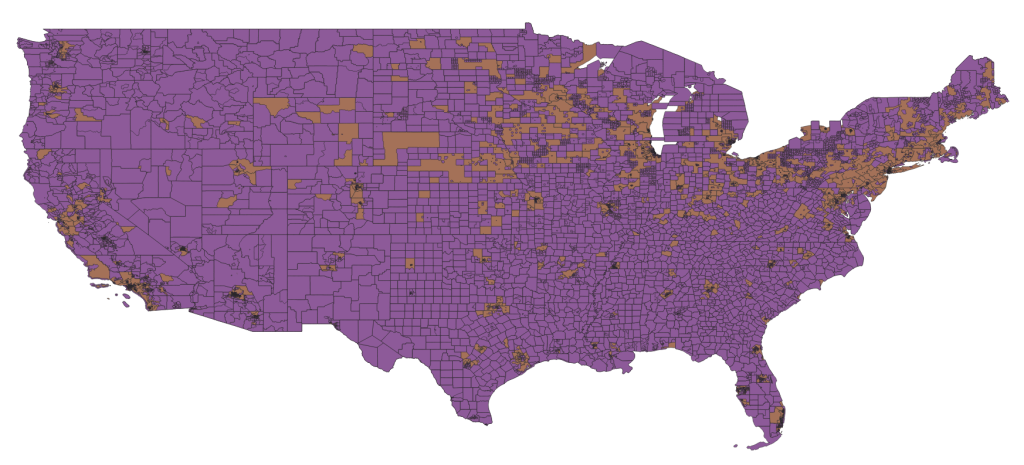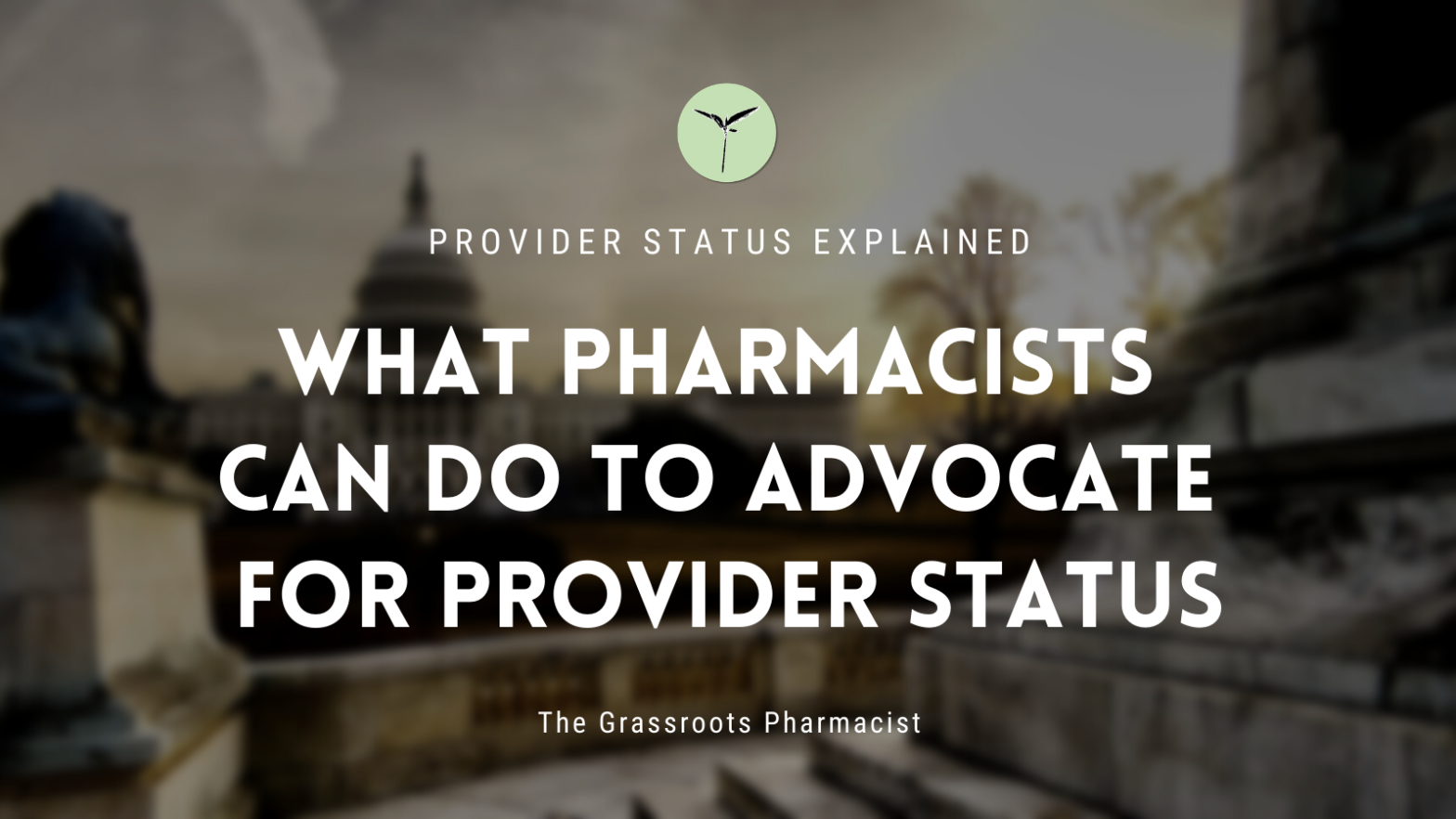Last week we got some incredibly exciting news with the introduction of H.R. 2759 – The Pharmacy and Medically Underserved Areas Enhancement Act — into the United States (U.S.) House of Representatives. This bipartisan piece of legislation was introduced by Representatives G.K. Butterfield (D-NC) and David McKinley (R-WV). As a quick reminder, this bill would increase access to pharmacists provided care in medically underserved areas by allowing for the reimbursement of services under the Medicare Part B benefit. We have already covered on the blog why pharmacists need provider status along with how pharmacists can be recognized as healthcare providers on the federal and state level. With this legislation officially introduced, now is the time to cover what we can do to advocate for this monumental advancement in patient care.
The necessity of grassroots advocacy
For many seasoned members of the profession, the introduction of a provider status bill in Congress may cause them to roll their eyes and say, “Here we go again. Another campaign that won’t work.” We can understand that reaction, as there have been nine provider status bills introduced in Congress over the past 20 years (107th, 108th, 109th, 110th, 111th, 113th, 114th, 115th, and now the 117th Congress). Although it can be disheartening not to see the passage of a bill, it is important to recognize that this is just a part of the legislative process as the advocacy and education that happens during each campaign builds momentum.
The long-term goal is to recognize pharmacists as providers under the Medicare Part B benefit. However, we cannot lose sight of the short-term goal: to provide education on the value of pharmacist-provided care. As we have described in previous posts, educating the public is an incredibly important piece of advocacy. If we can educate more members of the public on this issue through this advocacy campaign, it would be a major success. Ideally, this education would result in their support of our perspective on the issue and could further translate to additional advocacy efforts to elected leaders. Grassroots advocacy is in itself a form of influence. You hope that your perspective will influence your elected leaders in a way that will move them to active support. Influence takes a long time and often requires the formation of a relationship.
Addressing opposition through action
It may be surprising to think there would be an active opposition to pharmacists being recognized as healthcare providers, but unfortunately there is. The American Medical Association (AMA) passed official policy in 2012 within their House of Delegates (HOD) opposing expanded pharmacist scope of practice and pharmacist provider status. Just to be clear, there has been no indication yet that the AMA opposes H.R. 2759. However, as the AMA is a membership organization and the membership passed policy in their HOD, there should be no expectation that they would change their lobbying efforts without similar action in the HOD or action from their Board of Trustees.
The AMA is definitely unrivaled when it comes to lobbying power. As you can see from the data pulled below from OpenSecrets.org, the pharmacy profession’s political action committees (PAC) and lobbying expenditures are significantly lower than many medical associations. Before you panic and think there is no possible way to overcome all that political leverage, know that your voice as a constituent is more powerful than that of a lobbyist. In fact, research from the Congressional Management Foundation has proven exactly that. But it is important to note that you have to use your voice in order to tap into that power. If you want examples of bills the AMA lobbied against but were eventually passed, look no further than Medicare, Medicaid, and the Affordable Care Act. This number goes even higher when you consider the numerous types of regulations that executive agencies have issued over objection letters from the AMA. Although it took a long time for these bills to pass, it is important to recognize that opposition is no reason to remain quiet. It may actually be more of a reason to speak up!

In addition to the importance of grassroots advocacy and connecting with your elected leaders is the importance of joining and regularly contributing to professional associations. Of course, before making a contribution to any PAC, it is important to research the PAC. We recommend reading their most recent annual report and ensuring that their donations align with your expectations prior to becoming a contributor.
Communicating with your elected leader
We have covered in previous blog posts different ways to connect with your elected leader depending on the amount of time you have to invest, from 60 seconds to an hour. A great resource to utilize is the Action Center provided by the American Pharmacists Association. By entering in your contact information, you can quickly find your Congressional representatives and will be provided with a template letter. Now, the next step is incredibly important. Instead of just pressing send, take a few moments to personalize the letter. Research has shown that standardized form letters are a less effective method to influence legislators, but taking a few moments to share a personal story and why this bill is important to you and your patients will go an incredibly long way.
Connect to elected leaders’ constituency
As elected leaders in a representative democracy, our members of Congress have an inherent self-interest to support legislation that can directly improve the lives of those constituents who live in their district. Therefore, when advocating for an issue, it is vital to connect the impact of whatever you are advocating for to the constituency of the elected leader. Don’t make promises that constituents will vote for them if they support a piece of legislation (AKA quid pro quo), but help elected leaders make the connection that a piece of legislation will benefit their constituents.
The Pharmacy and Medically Underserved Areas Enhancement Act would directly increase access to care for Medicare beneficiaries in medically underserved areas. For the purpose of this blog post, we don’t need to get into too much detail around underserved areas. But you should know they are designated by the Federal government, there are different types, and they are areas that don’t have enough medical professionals to support the population. Therefore, an easy connection you could make for an elected leader is that the Pharmacy and Medically Underserved Areas Enhancement Act would increase access to care for their constituents specifically in these needed areas.
If you look across the continental U.S., you can see that a significant majority of the country is designated as underserved. We created the map below which shows these underserved areas in purple.

Let’s take a closer look at a case example of Ohio. In the below map, underserved areas are designated as a shade of blue, with darker shades of blue depicting that an area has been designated as several different types of a medically underserved area. We overlaid this over a map of Ohio’s 16 Congressional Districts which have been labeled with their respective number. As you can see, there are underserved areas in every member’s district, but some members have more underserved areas than others. For example, Representative Steve Chabot from District 1 has nearly no medically underserved areas in his district as compared to Representative Steve Stivers from District 15, whose almost entire district is an underserved area.

Helping your elected leaders to see how this legislation directly connects back to their district is vital. Follow these links to search for medically underserved areas and health professional shortage areas in your home state.
Advocate smarter, not harder
Given the bill’s focus on pharmacy, it is no surprise that the majority of our profession supports this legislation. However, it is important for our members of Congress to hear our support from us. But, if you only have minimal capacity to advocate for this important bill, consider the impact individuals outside the profession of pharmacy could have. Physician or nursing colleagues, and even patients, can provide an incredibly effective voice in supporting this bill. Support of physicians can especially help to showcase that the potential opposition of the AMA is not truly representative of the physician community. So many pharmacists have incredible partnerships with other members of the healthcare team and with their patients. It is important to help members of Congress see that the passage of this legislation is not only important to members of the profession of pharmacy, but also to other members of the healthcare team and to our patients.
The focus is the patient
One of the reasons we started this blog is because we have seen a lot of misinformation shared on social media regarding health policy issues that impact pharmacists. We have seen a lot of posts similar to the one below that implies that provider status will dramatically increase pharmacists’ salaries.

The impact of provider status on the pharmacist salary likely deserves its own blog post, but regardless, this should not be the motivation for passing this legislation. The Pharmacy and Medically Underserved Areas Enhancement Act would increase access and efficiency of healthcare. We advocate for this bill because it could help patients. End of reason to care about an issue. Period.
How to track advancements of provider status
If you are interested in staying up to date on this legislation, there are several options for you. Of course, we encourage you to follow the blog as we will keep providing updates as they happen. Joining professional associations will also allow you the opportunity to stay informed on this bill. Another way is to track the legislation yourself and sign up for alerts on Congress.gov.
Now is our time to act as advocates for increased access to pharmacist-provided care. There have been decades of efforts providing education to members of Congress on the role and value of the pharmacist. We can build upon that education to reach for the ultimate success of the pharmacist recognized as a provider under the Medicare Part B benefit. Grassroots advocacy never stops, and the future for patient care holds so much opportunity.

How can one obtain a copy of the purple US map that you created so that it can be overlaid on topp of their state’s congressional districts? Thank you very much for all your help with this worthy cause!
LikeLike
Hi Carol, the map was made with a geospatial software called QGIS and unfortunately the version of the map is only available on my desktop computer. If you send us an email at grassroots.rph@gmail.com with which state you are from I would be happy to make you a version and send to you this coming weekend!
LikeLike